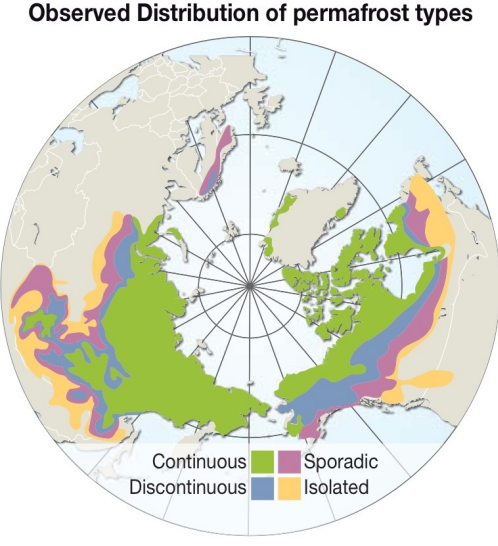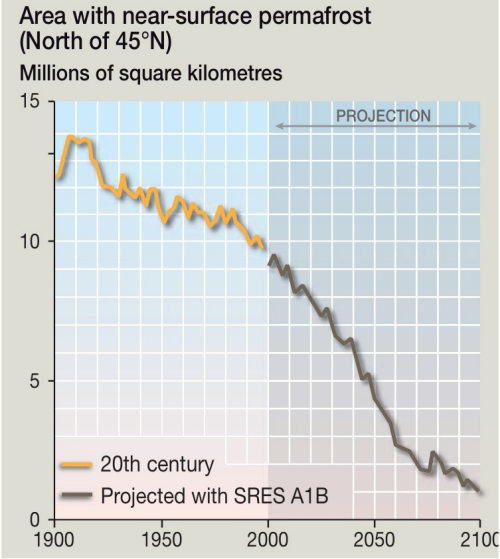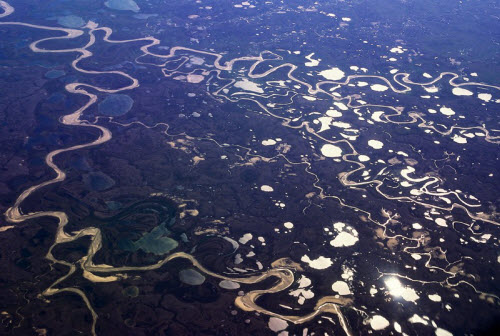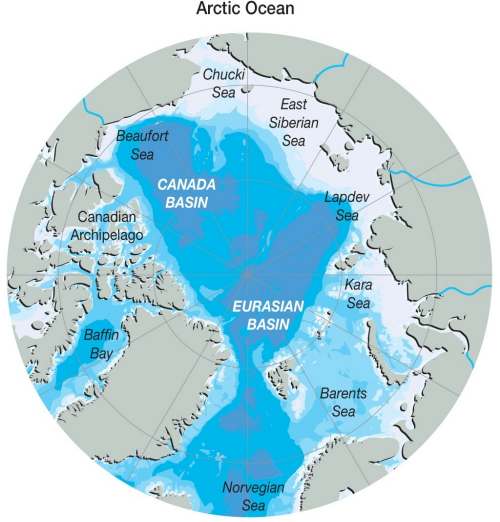Not so Permanent Permafrost
Posted on 26 October 2011 by Riduna
Introduction
Permanently frozen ground or permafrost occurs and persists where the mean temperature above ground is 0°C or less, resulting in soil, rock and their content being frozen and remaining frozen for at least 2 consecutive years. Permafrost is most common in higher latitudes of the northern hemisphere where it occurs over 24% of the landmass. It commonly has a depth of 0.6 to 150 metres, though depths of 1,500 metres are known. Soil temperature below 5 metres tend to remain stable even though surface temperature may seasonally thaw the active zone where limited plant growth is possible.
The content of soil affected by permafrost often includes water, accumulated organic matter (biota) and methane produced from biota decay when temperatures were warmer. The presence of permafrost prevents such decay and methane emission. Water contained in the soil is present in the form of ice which binds composite material together. The presence of ice, often close to the surface, prevents water flow so land affected by permafrost tends to be poorly drained and to be swampy or peatland when the active layer thaws briefly in summer. Thawing usually occurs from the surface downwards and in the Arctic seldom penetrates more than 1 metre.
In the Arctic and adjacent lands, where sub-surface temperature is lower than -5°C, permafrost is continuous, ice in the soil is near the surface but is sensitive to temperature and within a degree or so of thawing. Where sub-surface temperature is between -2°C and -4°C, permafrost is discontinuous, is present in 50% to 90% of the land area and ice near the surface is within a fraction of a degree of melting. Partial permafrost can form where sub-surface land temperature is 0°C to -2°C and occurs in 10% to 50% of the land area though ice is usually not found close to the surface, permitting more diverse flora and fauna to flourish.
Fig. 1 Distribution of permafrost. Continuous occurs in 100% of land area, Discontinuous occurs in 50-90% of land area, Sporadic occurs in 10-50% of land area. Courtesy Riccardo Pravettoni, UNEP/GRID-Arendal
Permafrost thaws when the land surface is disturbed or when temperature above the surface exceeds 0°C. Anthropogenic activities have now elevated CO2 in the atmosphere causing warming to levels where on-shore permafrost is beginning to thaw, enabling decay of biota to resume and stored CH4 to be emitted into the atmosphere at an accelerating rate. In 2005 Shakhova et al (2010) measured methane entering the atmosphere from the East Central Siberian (ECS) continental shelf at 8 million tonnes per annum. It is estimated that onshore emissions from thawing yedoma and biota are presently ~4 million tonnes per annum.
Greenhouse gas emissions
Yedoma is a Pleistocene permafrost rich in organic material and loess bound together by ice which makes up 50 to 90% of its content. It is most commonly found in Eastern Siberia where it covers ~1 million km2 and can be >20 metres thick. Because of its high ice content, thawing and refreezing produces a thermokarst landscape of ponds and lakes (Fig 3) permitting biota to resume decay and emit greenhouse gases. Yedoma contains about 2% methane by volume and Siberian deposits, estimated to contain over 500 gigatonnes, are a major source of this gas.
All of the gas escaping from these sources enters the atmosphere as CH4 with a Global Warming Potential ~72 times greater than CO2 over a 20 year time horizon during which CH4 oxidizes to CO2. It therefore has an immediate and powerful warming affect on the Arctic and contributes to temperature amplification in this and sub-Arctic regions. It is estimates that annual methane emissions in the Arctic will increase to 1.5 billion tonnes of carbon per annum before 2030 and Shakhova predicts that emissions from the ECS alone could rise to >3 billion tonnes per annum later this century.
Releases of this magnitude are predicted to increase average global temperature by at least 4°C to 6°C, and by 6°C to 10°C in the Arctic before 2100. Importantly, combined with loss of Arctic sea ice, it will also produce considerable warming of ocean water. Inevitably, melting of permafrost, already evident, will accelerate significantly in coming years, both onshore and on the seabed. Assessment of the effects this will have is important so that we are aware of the consequences and, where possible, can plan and institute remedial or mitigating action.
The Arctic tundra covers an area of ~10.360 million km2 and is covered by continuous permafrost. It is estimated that this area contains an incredible 1.5 trillion tonnes of CH4, some stored in clathrate far beneath the surface, much of it in frozen biota at near surface depth, covered in permafrost insulating and stabilizing that material. Surface permafrost has probably been slowly melting since CO2 concentration in the atmosphere rose above 280 ppm and has been releasing progressively larger CH4 amounts each year.
Fig. 2 Actual Modeled and projected loss of permafrost. By 2100 permafrost will have thawed to a depth of 3 meters producing slope instability in mountain areas. Courtesy UNEP/GRID-Arendal Updated 10/12/11
Since 1988 when CO2 reached 350ppm, the rate and extent of permafrost thaw has increased significantly, and, combined with reduced albedo, elevating temperature – a feature known as Arctic amplification, speeding-up carbon feedback. The effects of this are evidenced by Landsat and other data sources, showing coastal erosion over the 20 years 1986-2005 was double that of the preceding 30 years.
Arctic warming, consequential thawing of permafrost and associated carbon feedback are expected to accelerate the rate of thawing throughout the 21stcentury. As permafrost thaws it permits biota to resume decay, producing methane and emitting it at a much increased rate. Wickland et al (2006) find that poorly drained peat soils in Alaska emit 15 to 28 times more greenhouse gas when free of permafrost than do soils where permafrost is present.
Lawrence et al (2005) estimate that permafrost covering ~9.5m km2 will have thawed to a depth of 3 meters by 2100. This thawing will make sediments wet, plastic and unstable producing change to the land surface through formation of wetlands, gullies and sinks. It results in land subsidence and expansion causing land surface distortions, reducing its load bearing capacity and producing instability of mountain slopes. The latter is exacerbated when permafrost refreezes, producing massive slides of rock, gravel and other material.
Fig 3. Wet Tundra in the Russian Arctic. Thawing of surface permafrost creates poor drainage causing them to turn into soggy bogs in summer which re-freeze in winter, a typical thermokarst landscape. Courtesy UNEP/GRID-Arendal
Flora and Fauna
Over the 21st century, extensive melting of permafrost will produce geomorphology substantially changing the existing environment. Tundra plants are limited to grasses, sedges, lichens and mosses which have specialized to withstand the harsh Arctic climate and limited hours of sunshine. They are being displaced by sub-Arctic flowering plants, small shrubs and trees. The tree-line is predicted to move north encroaching on tundra at rates of up to 6 kilometres a year in some places, though generally slower advance is predicted.
Animal species which are well adapted to tundra flora and climate are highly susceptible to environmental change. It is likely that many could be faced with extinction unless they can adapt to a rapidly changing environment. Rising temperatures and spread of flora found south of the tundra will limit food availability for grazing animals such as moose, caribou, reindeer and musk ox. Melting permafrost will cause development of extensive swamps, likely to impede migrating animals and their vulnerable young. Reduction in their number will in turn threaten predator species such as wolves and Arctic fox.
Coastal erosion
Expectations are that erosion of the coastline will occur where there is a rise in sea level. Bruuns Rule states that on average each 1cm of sea level rise results in about 1m of coastal recession. In other words, for each meter of sea level rise, the coastline is eroded, over time, by 100 meters. While this Rule has global application, coastal erosion in the Arctic is occurring at a much faster rate than predicted because of permafrost thawing and exposure of shorelines to wave action.
Around 60% of the Arctic Ocean shoreline is stabilized by permafrost binding silt, gravel and other material together. Until recently they have been protected by sea ice from ocean wave action, however coastlines are remaining ice-free for longer periods each year. Shorelines are now seasonally exposed to relatively warm seawater, the erosive action of waves and autumnal storm surges. The result is that binding permafrost is being melted and shorelines are being eroded by wave action by up to 20 meters per annum in some parts, particularly at river deltas. This threatens human settlements, salinates fresh water sources and damages other habitat. The entire Arctic coastline has become labile, markedly so along shorelines of the Laptev, East Siberian and Beaufort seas.
Fig 4. Coastal erosion is extensive along Arctic Ocean shorelines, particularly of the Laptev, East Siberian and Beaufort Seas. Courtesy Riccardo Pravettoni,UNEP/GRID-Arendal
Global average sea level rise is presently 3.3mm per annum so, according to Bruuns Rule we should be seeing average coastal erosion ~33cm per annum. In the Arctic we find average erosion along 100,000 km of coastline is 1-2 meters per annum.
Socio-economic effects
All of the Arctic landmass, generally defined as the area contained by the 10°C thermoline, is affected by permafrost. The Arctic has a population of 4-5 million(half living in Russia), several sizeable cities and major extractive industries - particularly oil and gas.
These are supported by an extensive transport infrastructure including roads, railways, bridges, airports, pipelines, dams and port facilities. Cities and smaller settlements comprise dwellings, schools, hospitals, industries and businesses, as well as water and sewage treatment facilities. Many of these assets are built on what were solid permafrost foundations often less than 3 metres deep.
Vast sums of money and decades of human endeavour in creating these assets will be at increasing risk where the foundations on which they rest, permafrost, begin to melt. This melting has already started and is expected to accelerate and become more extensive throughout the 21st century. It can be slowed by reducing CO2emissions but it can no longer be stopped, except by the onset of an ice age and there is no known defence against its ruinous effects.
It is likely that in a decade or so, many more structures will be at risk of collapse or becoming unusable due to instability of the ground on which they are built. The load bearing capacity, alignment and stability of roads and bridges may be adversely affected and ground traversed by gas and oil pipelines may no longer be able to support their weight.
The socio-economic impact of these developments is likely to be significant over the next 50 years. The largest industries throughout the Arctic involve mineral, oil and gas production.
- In the Russian Arctic, they are particularly important, accounting for 11% of GDP, 75% of the oil and all of the gas needed for domestic consumption and ~22% of Russia’s exports.
- In the Canadian Arctic, diamond mining is presently the largest industry though gold tungsten and other minerals are also produced. Considerable oil and gas reserves are planned to be developed. Apart from Yellowknife (19,000) there are no towns of any size.
- In Alaska, oil and gas production are the largest component of the State economy while zinc mining in the north-west makes an important contribution. The Alaskan Arctic has no major cities, though Fairbanks (35,000) is built on permafrost affected land.
Commercial activities in the Arctic are large, important to national economies and for the viability of local population centres. Monitoring of permafrost melting and associated greenhouse gas emissions is undertaken by ground instruments and satellites. However, unless technology able to replace melting permafrost with an affordable, durable load bearing foundation can be applied, it should be accepted that virtually all existing buildings and structures located on permafrost with foundations less than 5 metres deep are likely to be damaged or destroyed before 2100.
Conclusions
Permafrost is an immense CH4 reservoir and although present levels of emission are low, they are expected to substantially increase this century, accelerating warming in higher latitudes and globally. This is a major concern since it will produce growing feedback resulting in gradual increase of the speed, depth and extent of permafrost thawing further increasing CH4 emissions. The result will be on-going and more extensive land destabilization, distortion of surface and subsurface material and development of swamplands.
These will have profound impacts on flora and fauna, particularly species which have adapted to tundra conditions. Because of the speed and extent of permafrost thawing, they may have insufficient time to adapt to these changes and could face extinction. At the same time, warming and other changes to the environment are resulting in northward movement of species.
Permafrost loss combined with retreat of sea ice is producing very rapid coastal erosion in the order of 5-6 times faster than that caused by rising sea level. It is affecting some coastal communities, causing them to move to more stable land. More significant will be the damage to buildings and infrastructure now becoming evident as a result of land movement caused by loss of permafrost. This damage is expected to increase over the next 50 years, and have substantial adverse effects on the Arctic economy.
These outcomes may be slowed by rapid reduction of anthropogenic greenhouse gas emissions but they can not be stopped or reversed. Without application of technology countering the effects of permafrost thawing on existing buildings and infrastructure, damage to them can not be prevented. Nor can a dangerous increase in the venting of CH4 into the atmosphere.































 Arguments
Arguments


































[DB] Fixed links (all of them, I think). Made all graphics expandable (if larger scale available).
[DB] Figure 2 is derived from this study.
[DB] "Perhaps Agnostic yielded to the convenience of graphs that showed most of the information in an at-a-glance format."
Something that most authors do on a fairly regular basis - myself included.
A request for clarification has been sent.
[DB] "Is it "goofy" to try and determine whether what SkS portrays as "actual" 20th century near-surface permafrost area is indeed based upon actual observations?"
You have been told that verification is being sought. Your continued intransigence in not patiently awaiting a reply speaks volumes.
"Only by following the trail back from UNEP to WWF to Lawrence et al 2008 was I able to determine that the "actual" graph is most likely the result of cascaded simulations."
"Likely"? "able to determine"? You speak as if this was some mythic revelation revealed only to you. Everything you surmise after this is mere supposition by you.
Again, confirmation is being sought. Patience is counseled.
"This has become a moot point since it has become clear that the data is not what the SkS article claims it is -- "actual"."
Now you pass from tedious through tepid to inflammatory. Do not presume malfeasance when mere human error is far more likely. And said error is not yet revealed to be on the part of SkS.
Further intimations of impropriety will be deleted outright.
[DB] "unfortunately it is still not clear what data WWF used"
What part of
did you not read or understand?
"even a cursory comparison shows that this is incorrect"
Eyecrometers lack scientific accuracy. FYI.
"This has become a moot point since it has become clear that the data is not what the SkS article claims it is"
Actually, it has become moot due to being superceded by the graph from Lawrence et al 2011, which you appear to have not yet read either.
Tedious moderator trolling snipped.
[DB] "I did not realize that asking for the source of data for Figure 2 would cause such controversy."
You asked a fair question and were given a fair answer. No controversy at all.
[DB] "How accurate are the models"
Off-topic on this thread. See Most Popular Skeptic Argument #6 on the left, Models are unreliable.
You have been warned previously about complaints about moderation and being off-topic. Please note that posting comments here at SkS is a privilege, not a right. This privilege can and will be rescinded if the posting individual continues to treat adherence to the Comments Policy as optional, rather than the mandatory condition of participating in this online forum.
Moderating this site is a tiresome chore, particularly when commentators repeatedly submit offensive, off-topic posts or intentionally misleading comments and graphics or simply make things up. We really appreciate people's cooperation in abiding by the Comments Policy, which is largely responsible for the quality of this site.
Finally, please understand that moderation policies are not open for discussion. If you find yourself incapable of abiding by these common set of rules that everyone else observes, then a change of venues is in the offing.
Please take the time to review the policy and ensure future comments are in full compliance with it. Thanks for your understanding and compliance in this matter, as no further warnings shall be given.
Recommended supplemental reading:
Arctic carbon cycle is speeding up by Esprit Smith, Vital Signs of the Planet, NASA's Jet Propulsion Laboratory, Aug 3, 2018